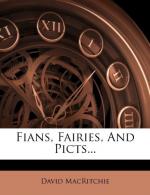[Footnote 8: By “mankind” need only be understood the race to which Einar Gudmund belonged. It is well known that many races apply the term “men” to themselves alone. At the same time, Gudmund’s words may denote a very marked difference in the two types.]
[Footnote 9: Scott again quotes this story, in fuller detail, in the Appendix to The Lady of the Lake, Note 3 C.]
[Footnote 10: “Primitive Culture,” vol. i. p. 385 (3rd edition).]
[Footnote 11: London, Macmillan and Co., 1873.]
[Footnote 12: London, Truebner and Co., 1883.]
[Footnote 13: London, David Nutt, 1891.]
[Footnote 14: Asiatic Quarterly Review, July 1892.]
[Footnote 15: For an exhaustive account of “The Pygmy Tribes of Africa,” treated from the purely scientific and ethnological point of view see Dr. Henry Schlichter’s articles in The Scottish Geographical Magazine of June and July 1892.]
[Footnote 16: Memoirs of the Anthropological Society of London, vol. iii. 1870, pp. 320, 321.]
[Footnote 17: Blackwood and Sons, 1888.]
FIANS, FAIRIES AND PICTS.
The general belief at the present day is that, of the three designations here classed together, only that of the Picts is really historical. The Fians are regarded as merely legendary—perhaps altogether mythical beings; and the Fairies as absolutely unreal. On the other hand, there are those who believe that the three terms all relate to historical people, closely akin to each other, if not actually one people under three names.
To those unacquainted with the views of the realists, or euhemerists, it is necessary to explain that the popular definition of Fairies as “little people” is one which that school is quite ready to accept. But the conception of such “little people” as tiny beings of aerial and ethereal nature, able to fly on a bat’s back, or to sip honey from the flowers “where the bee sucks,” is regarded by the realists as simply the outcome of the imagination, working upon a basis of fact. An illustration of this position may be seen in the Far East. There is a tradition among the Ainos of Northern Japan that they were preceded by a race of “little people,” only a few inches in height, whose pit-dwellings they still point out. But the pottery and the skeletons associated with these habitations show that not only were their occupants of a stature to be measured by feet rather than by inches, but also that, by reason of a certain anatomical peculiarity common to both, the traditional dwarfs were very clearly the ancestors of the Ainos—a race which, though now blended, was once most distinctly a race of dwarfs, if one is to believe the earliest Japanese pictures of them. Similarly, the dwarfs of European tradition are believed to have had as real an origin as the little people of Aino legend, at any rate by those who hold the realistic theory.




